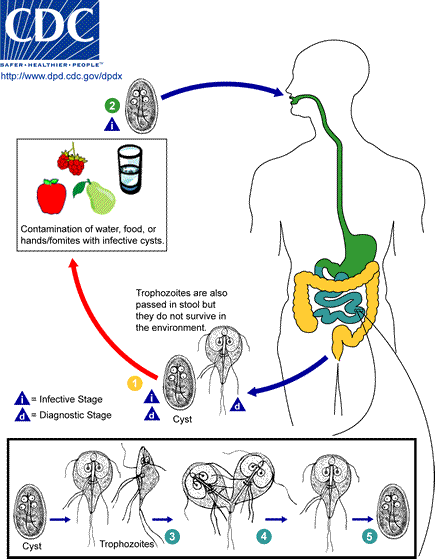Giardia lamblia or intestinalis is a protozoan parasite which infects the lining of the small intestine of its host. It has two distinct stages, the trophozoite stage, which is the active reproducing stage, and the cyst stage, which is the resting stage. Trophozoites are only found in the host because they are unable to survive in the external environment.
Giardia cysts on the other hand are very resistant to harsh environmental factors and can survive outside the host for prolonged periods. Once ingested by a suitable host, the trophozoites are encysted and infect the host’s small intestine. The trophozoites then reproduce and encyst again before being excreted to infect another host.
Common Sources of Giardia Infection: Giardiasis is most often linked to consumption of contaminated water, but raw produce and other foods have also been considered as possible vectors. Giardiasis can also be acquired by fecal-oral contamination particularly with children carrying in infection such as day-care centers. The infectious dose for giardiasis is one or more cysts. Giardia lamblia has been isolated from domestic cats and dogs as well as wild beavers and bears. Giardiasis is know to be the largest contributor to non-bacterial diarrhea in all of North America and infects roughly 2% of the population.
Symptoms of Giardia: Giardia lamblia causes the disease Giardiasis with symptoms of diarrhea, abdominal bloating, stomach cramps, nausea, vomiting, malabsorption syndrome causing steatorrhea (fat in the stool) fatigue and severe weight loss in chronic infections. While normal illness lasts only about 1-2 weeks, chronic infections can last for months or even years.
Diagnosis and Treatment of Giardiasis: Once diagnosed by fecal exam (of several samples) to detect eggs and trophozoites (the immature stages), Giardiasis can be treated with homeopathics and Metronidazole or Quinacrine. Drug resistance has been observed in some instances and in remote areas such as rural Asia, Africa, and Latin America, the disease accounts for thousands of deaths each year. Giardiasis can be found throughout the population—the acute form predominantly found in children and the chronic form mostly seen in adults.
Prevention of Giardiasis. Several chemicals (including bleach and iodine), filtration and high temperature treatments are effective for the inactivation of the parasite from water sources. Note chlorine will kill the adult Giardia, but not their eggs (called cysts). Proper sanitation is a must in controlling this disease.
References:
- Giardia lamblia lifecycle: https://www.dpd.cdc.gov/dpdx/HTML/Giardiasis.htm
- Giardia trophozoite picture: https://www.isradiology.org/tropical_deseases/tmcr/chapter9/epidemi.htm
- Giardia cysts: https://www.practicalscience.com/gl.html


